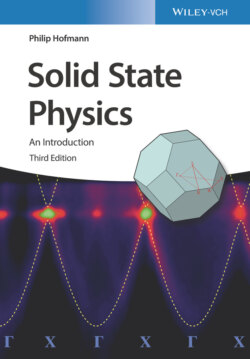Читать книгу Solid State Physics - Philip Hofmann - Страница 14
1.1 General Description of Crystal Structures
ОглавлениеOur description of crystals starts with the mathematical definition of the lattice. A lattice is a set of regularly spaced points with positions defined as multiples of generating vectors. In two dimensions, a lattice can be defined as all the points that can be reached by the vectors , created from two non‐collinear vectors and as
(1.1)
where and are integers. In three dimensions, the corresponding definition is
(1.2)
Such a lattice of points is also called a Bravais lattice. The number of possible Bravais lattices with different symmetries is limited to 5 in two dimensions and to 14 in three dimensions. An example of a two‐dimensional Bravais lattice is given in Figure 1.1. The lengths of the vectors and are often called the lattice constants.
Having defined the Bravais lattice, we move on to the definition of the primitive unit cell. By this we denote any volume of space that, when translated through all the vectors of the Bravais lattice, will fill space without overlap and without leaving any voids. The primitive unit cell of a lattice contains only one lattice point. It is also possible to define nonprimitive unit cells containing several lattice points. These fill space without leaving voids when translated through a subset of the Bravais lattice vectors. Possible choices of a unit cell for a two‐dimensional rectangular Bravais lattice are illustrated in Figure 1.2. It is evident from the figure that a nonprimitive unit cell has to be translated by a multiple of one (or two) lattice vectors to fill space without voids and overlap. A special choice of the primitive unit cell is the Wigner–Seitz cell, which is also shown in Figure 1.2. It is the region of space that is closer to one given lattice point than to any other.
The last definition we need in order to describe an actual crystal is that of a basis. The basis describes the items we “put” on the lattice points, that is, the building blocks for the real crystal. The basis can consist of one or several atoms, or even of complex molecules as in the case of protein crystals. Different cases are illustrated in Figure 1.3.
Figure 1.1 A two‐dimensional Bravais lattice.
Figure 1.2 Illustration of (primitive and nonprimitive) unit cells and of the Wigner–Seitz cell for a rectangular two‐dimensional lattice.
Figure 1.3 A two‐dimensional Bravais lattice with different choices for the basis.
Finally, we add a remark about symmetry. So far, we discussed only translational symmetry. However, a real crystal may also exhibit point symmetry. Compare the structures in the middle and the bottom of Figure 1.3. The former structure possesses a number of symmetry elements that are missing in the latter – for example, mirror lines, a rotational axis, and inversion symmetry. The knowledge of such symmetries can be very useful for the description of crystal properties.
